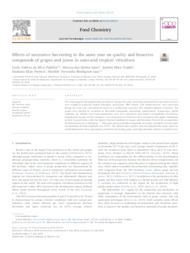Effects of successive harvesting in the same year on quality and bioactive compounds of grapes and juices in semi-arid tropical viticulture.
Effects of successive harvesting in the same year on quality and bioactive compounds of grapes and juices in semi-arid tropical viticulture.
Author(s): PADILHA, C. V. da S.; LIMA, M. dos S.; TOALDO, I. M.; PEREIRA, G. E.; BORDIGNON-LUIZA, M. T.
Summary: The technological and polyphenolic parameters of grapes for juice processing obtained from successive harvests were studied in semi-arid tropical viticulture. Red grapes ?BRS Violeta? and ?Isabel Precoce? were harvested during the same year and analyzed based on a multivariate approach that included climatic variations. The grapes were marked by variations in flavonoid compounds, particularly anthocyanins. Temperature, global radiation, air velocity and evapotranspiration rates were associated with higher accumulation of bioactive polyphenols in grape berries and juices. The temperatures in February were associated with higher antioxidant activity in grape peels, while the highest thermal amplitude in August and November favored the accumulation of anthocyanins up to 564 mg kg−1. Flavanols and procyanidin compounds were more abundant in seeds when the maximum thermal amplitude was 13.8 °C. The climatic data together with the polyphenolic results point out useful information about appropriate periods for harvesting grapes with high phenolic content in tropical areas.
Publication year: 2019
Types of publication: Journal article
Unit: Embrapa Semi-arid Region
Observation
Some of Embrapa's publications are published as ePub files. To read them, use or download one of the following free software options to your computer or mobile device. Android: Google Play Books; IOS: iBooks; Windows and Linux: Calibre.
Access other publications
Access the Agricultural Research Database (BDPA) to consult Embrapa's full library collection and records.
Visit Embrapa Bookstore to purchase books and other publications sold by Embrapa.

